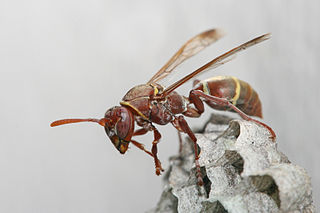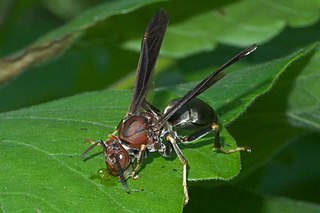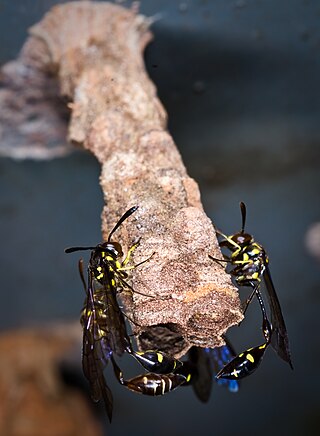
Wasps of the cosmopolitan genus Polistes are the most familiar of the polistine wasps, and are the most common type of paper wasp in North America. Walter Ebeling coined the vernacular name "umbrella wasps" for this genus in 1975 to distinguish it from other types of paper wasp, in reference to the form of their nests. It is also the single largest genus within the family Vespidae, with over 300 recognized species and subspecies. Their innate preferences for nest-building sites leads them to commonly build nests on human habitation, where they can be very unwelcome; although generally not aggressive, they can be provoked into defending their nests. All species are predatory, and they may consume large numbers of caterpillars, in which respect they are generally considered beneficial. The European paper wasp, Polistes dominula, was introduced into the US about 1981 and has quickly spread throughout most of the country, in most cases replacing native species within a few years. This species is very commonly mistaken for a yellow jacket, as it is black, strongly marked with yellow, and quite different from the native North American species of Polistes. The cuckoo wasp, Polistes semenowi, is an obligate social parasite, whose only host is P. dominula. Polistes metricus adults malaxate their insect prey by chewing them into a pulp, sucking out and ingesting the body fluids, then feeding the rest of the morsel to their larvae. The most widely distributed South American wasp species, Polistes versicolor, is particularly common in the southeastern Brazilian states. This social wasp is commonly referred to as the yellow paper wasp due to the distinct yellow bands found on its thorax and abdomen. Polistes wasps can be identified by their characteristic flight; their long legs dangle below their bodies, which are also more slender than a yellow jacket.

The Polistinae is a subfamily of eusocial wasps belonging to the family Vespidae. They are closely related to the more familiar wasps and true hornets of the subfamily Vespinae, containing four tribes. With about 1,100 species total, it is the second-most diverse subfamily within the Vespidae, and while most species are tropical or subtropical, they include some of the most frequently encountered large wasps in temperate regions.

Ropalidia marginata is an Old World species of paper wasp. It is primitively eusocial, not showing the same bias in brood care seen in other social insects with greater asymmetry in relatedness. The species employs a variety of colony founding strategies, sometimes with single founders and sometimes in groups of variable number. The queen does not use physical dominance to control workers; there is evidence of pheromones being used to suppress other female workers from overtaking queenship.

Polistes metricus is a wasp native to North America. In the United States, it ranges throughout the southern Midwest, the South, and as far northeast as New York, but has recently been spotted in southwest Ontario. A single female specimen has also been reported from Dryden, Maine. Polistes metricus is dark colored, with yellow tarsi and black tibia. Nests of Polistes metricus can be found attached to the sides of buildings, trees, and shrubbery.

Polistes fuscatus, whose common name is the dark or northern paper wasp, is widely found in eastern North America, from southern Canada through the southern United States. It often nests around human development. However, it greatly prefers areas in which wood is readily available for use as nest material, therefore they are also found near and in woodlands and savannas. P. fuscatus is a social wasp that is part of a complex society based around a single dominant foundress along with other cofoundresses and a dominance hierarchy.

Belonogaster juncea is a typical quasisocial paper wasp from sub-saharan Africa and south-western Asia. It is the type species for the genus Belonogaster.

Polistes carolina is one of two species of red paper wasp found in the eastern United States and is noted for the finer ridges on its propodeum. It is a social wasp in the family Vespidae. They are native to the United States from Texas to Florida, north to New York, and west to Nebraska. The wasp's common name is due to the reddish-brown color of its head and body. P. carolina prefer to build their nests in protected spaces.

Polistes nimpha is a eusocial paper wasp found all over Europe, with particular sightings in Turkey, Finland, Estonia, and Latvia. It is also found in northern Africa, Pakistan, Iran, India, Kazakhstan, Mongolia, and China. The climate in these areas is relatively cold and snowy in the winter, while summers are usually hot and dry, with steppe vegetation. Polistes nimpha colonies are relatively small and easily manipulated.

Agelaia vicina is a species of wasp in the genus Agelaia. They are neotropical social wasps known to have the largest colony sizes and nest sizes among social wasps, with some colonies exceeding over one million individuals. They are predators of land arthropods, consuming both insects and spiders alike. Recent sperm morphology studies have shown that although Vespidae belong to the superfamily Vespoidea, A. vicina may be more phylogenetically related to Apoidea.

Polistes bellicosus is a social paper wasp from the order Hymenoptera typically found within Texas, namely the Houston area. Like other paper wasps, Polistes bellicosus build nests by manipulating exposed fibers into paper to create cells. P. bellicosus often rebuild their nests at least once per colony season due to predation.

Agelaia pallipes is a species of social paper wasp found from Costa Rica to Brazil, Argentina and Paraguay. A. pallipes is ground-nesting and is one of the most aggressive wasps in South America. This species is a predator of other insects, including flies, moths, and ground crickets, as well as baby birds.

Polistes biglumis is a species of social wasp within Polistes, the most common genus of paper wasp. It is distinguished mainly by its tendency to reside in montane climates in meadows or alpine areas. Selection pressure from the wasp's environment has led to several idiosyncrasies of its behavior and lifecycle with respect to its relative species in the genus Polistes. It alone among paper wasps is often polyandrous. In addition, it has a truncated nesting season that gives rise to unique competitive dynamics among females of the species. P. biglumis wasps use an odor-based recognition system that is the basis for all wasp-to-wasp interaction of the species. The wasp's lifecycle is highly intertwined with that of Polistes atrimandibularis, an obligate social parasite wasp that frequently invades the combs of P. biglumis wasps.

Ropalidia revolutionalis, the stick-nest brown paper wasp, is a diurnal social wasp of the family Vespidae. They are known for the distinctive combs they make for their nests, and they are mostly found in Queensland, Australia in the areas of Brisbane and Townsville. They are an independent founding wasp species, and they build new nests each spring. They can be helpful because they control insect pests in gardens.
Ropalidia plebeiana is a eusocial temperate paper wasp. It is unique, as it is the only temperate wasp in the typically tropical Ropalidia genus. R. plebeiana is widely distributed in eastern Australia, and recently have been found making huge nest aggregations, with thousands of nests on trunks of trees, in south-eastern New South Wales.

The Black hover wasp, Parischnogaster alternata, is a eusocial wasp in the genus Parischnogaster. It is native to South-East Asia, and builds its nests in cavities located in dark and damp locations. The nests of Black hover wasps are often found in clusters, which serves as a passive defense mechanism against predators. The annual colony cycle begins with nest initiation by a single foundress though colonies typically consist of 2-3 associative females and helpers that aid in brood development, nest construction, and colony defense. Indicative of the name, female P. alternata are known to strategically hover near nests when visiting other colonies before landing. These intrusions produce responses ranging from aerial fighting to cooperative food sharing.
Mischocyttarus drewseni, which is sometimes spelled "drewsenii", is a social wasp in the family Vespidae. It is commonly found in Neotropical regions of South America, including Brazil, Peru, Venezuela, Colombia and Paraguay. This mid-sized wasp is about 1.5-1.8 cm and is typically dark brown or black in color. This species makes their nests out of woody plant fibers and create single combed nests with hexagonal cells which are typically found in low lying grass habitats or semi-urban environments. The colony cycle for this species is initiated by the queen who starts building the nest cell by cell. The nest construction process is highly elaborate and involves foraging for materials, creating cells, and heightening cell walls. It feeds on arthropods, plant nectar, and honeydew, and the species is very protective of its brood when it comes to defending them from their predators. The life cycle of this species has several stages with varying lengths, including egg, larval, pupal, and adult stages. As a social wasp species, there are several castes within the colony and different castes perform different specialized jobs with differing dominance and reproductive behaviors.

Mischocyttarus flavitarsis is a social paper wasp found in western North America. Their nests can be found both in forests close to rivers or in close proximity to human life under the eaves of roofs. Despite the fact that M. flavitarsis nests are frequently in close contact with humans, M. flavitarsis typically will not sting, but rather ram into the threatening individual. Their colony cycle typically begins before May and will last until October. The queen will then seek a hibernation site for the winter. Perched near female hibernation sites are males with whom the female will mate. The males have claimed their territory by rubbing sternal brushes along the border of the site, leaving a chemical that deters other individuals from approaching. M. flavitarsis feed on arthropods, nectar, and animal carcasses and are often prey to birds, ants, and praying mantis.

Polistes dorsalis is a species of social wasps that can be found throughout various parts of North America. It is classified under the Vespidae within the genus of Polistes. Male Polistes dorsalis wasps can be distinguished from other Polistes species by their distinctly prominent median tubercle of sternum 7. Both sexes can also be recognized due to their v- shaped yellow markings on their head. They are distributed widely across North America and can be found in sheltered nests, typically closer to the ground. These wasps live in a dominance hierarchy in which the queen's role differs from that of ordinary workers. When threatened, these wasps can deliver moderately painful stings. Their venom might also be of human interest for their antimicrobial uses.
Polistes erythrocephalus is a species of paper wasp in the subfamily Polistinae of family Vespidae found in Central and South America. P. erythrocephalus is a eusocial wasp, meaning that it possesses both reproductive and non-reproductive castes. The cooperation between the two castes to raise young demonstrates the altruistic nature of these wasps. P. erythrocephalus exhibits a four-stage colony cycle, as do many other Polistes wasps. This species generally feeds on larvae, occasionally their own, and is preyed upon by species such as army ants.

Mischocyttarus mexicanus cubicola is a neotropical subspecies of paper wasp found in the New World. It is a social wasp that demonstrates two different types of nesting strategies, depending upon context. This context-dependent trait makes Mischocyttarus mexicanus cubicola a good model to study social biology within social wasps. In detail, this trait allows for the females of this species to form nests both individually and as co-founders with other females within the same colony. This subspecies is also known to exhibit cannibalism, with M. m. cubicola queens feeding on their own larvae for nourishment when unaided by workers.




















